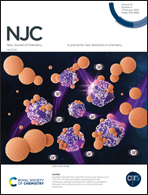Electromagnetic shielding performance of polyaniline-nanorod/graphene-nanoflake hybrid films in the S- and X-bands†
Abstract
Polyaniline (PANI) is an excellent lightweight electromagnetic shielding material with interesting features like flexibility and tuneable electrical conductivity. Moreover, it is corrosion-free, inexpensive and can be easily synthesized. Shielding by absorption, reflection or both can be realised in PANI depending on the requirements. An effective method to achieve very high attenuation is to form composites with materials such as graphene, metal nanoparticles and other high dielectric materials. However, most of the studies are based on shields of thickness ranging from a few hundred micrometres to millimetres. This work explores the EMI shielding properties of the composites of PANI with graphene in the S- and X-bands. Shielding effectiveness values as high as 57 dB are realised in these hybrid films of ∼10 μm thickness, rendering them suitable for lightweight and robust applications. It is found that the concentration of graphene in the PANI matrix significantly influences the shielding performance of these hybrid films and an optimum concentration of 2% graphene can make the absorption dominant shielding mechanism to be highly significant.



 Please wait while we load your content...
Please wait while we load your content...